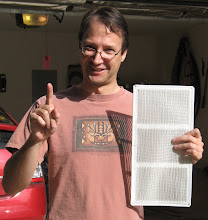Using the insulation blower was fairly simple, but certainly required two people for any reasonable amount of insulation. My volunteer neighbor stayed on the ground in the garage, wearing an insulation mask and feeding bags of compressed insulation into the blower. The blower, which had a set of rotating paddles inside it, tore up the compressed insulation into small enough bits that they would be blown out through the long hose. I stood in the attic with the other end of the hose, blowing a fine snow of expanded fiberglass insulation a good 15 or 20 feet out in front of me.
We quickly learned a few things:
- It takes a _long_ time to feed in a bag of insulation and get it fully blown out into the attic. We had 12 bags, and it took us roughly 8 hours to get the job done. There was some break time to cool down, clear out the machine, etc. but the job was very slow. Perhaps some machines are faster, but ours was pretty slow.
- You want to plan your route as if you were a painter; that is, work from the farthest edges back towards your attic entrance, so you aren't "painted into a corner". This helps keep the hose out of the way as well as keeps you from having to traverse over, and compress (which reduces the R-value) the newly blown insulation.
- You might also want to plan the various positions in the attic where you are going to stand. As you might expect, the insulation shoots out in a nice arc through the air slowing as it gets further away, with the insulation landing in a nice linear pile under the arc, with most of it landing on the half further away from you. Therefore, you want to fill places that are _not_ right next to you, but are further away. If you point the hose at the floor less than about 10 feet away, you'll just be blowing insulation out of the way with the force of the air, reducing the insulation coverage instead of adding to it. Instead, you want to shoot the air _over_ the area you want to fill, and let the insulation drift down into the area. If you don't understand this, don't worry - you'll learn it pretty quickly as you work.
- Since communication is nearly impossible between the hose operator and the machine operator due to distance and machine noise, you'll want to coordinate so that you know when to move to your different blowing positions to get an even distribution. I would ask my neighbor to cut off the machine after 2 more bags, for example, so I would know that I had blown enough insulation in that particular area.
- Operating the hose is actually peaceful, almost trance-inducing work. There is a certain beauty (at least to those schooled in the ways of Energy Efficiency) to watching the myriad fiberglass snowflakes dancing down, slowly gathering into giant drifts of heat-flow reducing goodness.


No comments:
Post a Comment